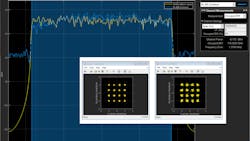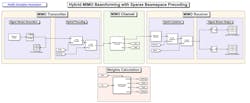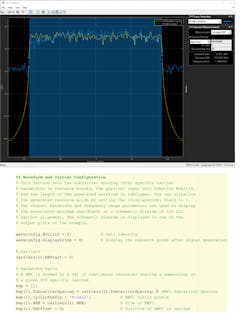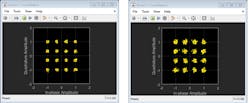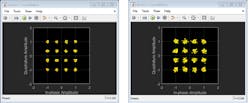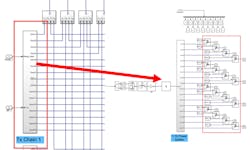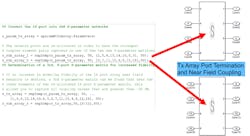Algorithms to Antenna: Exploring Hybrid-Beamforming Architectures for 5G Systems
We have blogged about various aspects of 5G New Radio (NR) systems that use MIMO beamforming for signal-to-noise ratio (SNR) enhancement and spatial multiplexing to improve data throughput in scatterer-rich environments. To gain higher throughput, MIMO beamforming implements precoding on the transmitter side and combining on the receiver side to increase SNR and separate spatial channels.
A full digital beamforming structure requires each antenna to have a dedicated RF-to-baseband chain, which can increase the overall hardware cost as well as the power consumption. As a solution, hybrid MIMO beamforming requires fewer RF-to-baseband modules. With deliberate selection of weights for precoding and combining, hybrid beamforming can achieve a level of performance that’s comparable to full (all digital) beamforming.
In the hyperlink provided above, we showed how system models can be developed with a focus on baseband equivalent models. These types of models can be developed quickly and provide minimal simulation duration. Subsystems can then be integrated to form a physical-layer simulation. You can use the resulting model to drive beamforming partitioning decisions between RF and digital domains.
The examples reviewed in previous blogs were implemented in the MATLAB environment via scripts, but we continue to get many questions on how to transition this type of design to Simulink. Two commonly asked questions are “How can I use Simulink for architectural analysis?” and “How can I use Simulink for multidomain (baseband and RF) simulation?” To help answer these questions, we developed a baseband hybrid MIMO beamforming example to help start your system-level design.
In the example, we use two hybrid-beamforming algorithms: Quantized Sparse Hybrid Beamforming (QSHB) and Hybrid Beamforming with Peak Search (HBPS).
Hybrid Beamforming Architecture
Figure 1 illustrates a block diagram of a hybrid-beamforming system with a transmitter, a channel, and a receiver.
The parameters shown are defined as follows:
- FRF = analog precoder
- FBB = digital precoder
- WRF = analog combiner
- WBB = digital combiner
- H = MIMO channel matrix
- NT = number of Tx antennas
- NR = number of Rx antennas
- NS = number of Tx RF chains
- NTRF = number of Tx RF chains
- NRRF = number of Rx RF chains
In the framework described below, you can explore different combinations of values for the number of antennas and RF chains in your system. The number of RF chains is important because this is where it’s possible save cost. By “sharing” the digital weights across multiple RF channels, less hardware can be used. The challenge is to reduce hardware without impacting system performance.
Building the Model
Figure 2 shows the Simulink model of a massive-MIMO system with hybrid beamforming. You can generate both the RF phase shifts and digital weights directly for each configuration you consider. While the system described here is based on QSHB and HBPS, you can also extend this model to custom algorithms that you develop.
The model of the system consists of the following four major components:
- MIMO transmitter
- MIMO channel
- MIMO receiver
- Hybrid weight calculation
You can integrate a specific MIMO channel matrix H. The channel can be estimated in the transmitter or receiver depending on the time- or frequency-division duplexing (TDD or FDD) modes used.
The structures of the transmitter, receiver, and MIMO channel blocks are independent from the precoding and weight matrix generation. The QSHB and HBPS algorithms are implemented in the Weight Calculation block of the model. These can be customized for your system.
The generated MIMO channel matrix H is invariant to the number of transmitted symbols. Therefore, the precoding and combiner matrices will be the same for all symbols.
The MIMO transmitter generates the signal stream and applies the precoding to leverage spatial multiplexing. The modulated signal is propagated through a scattering channel defined in the MIMO channel and then decoded and demodulated on the receiver side.
MIMO Transmitter and Receiver
For the transmitter and receiver subsystems, the focus of the engineering tradeoff is cost vs. performance. This in turn drives partitioning of the beamforming architecture between the RF and digital domains. At this point, you can answer the question on how to perform architectural analysis. In the example, two signal streams are generated. The transmitter system consists of 64 transmit antennas with four transmit RF chains. There are 16 receive antennas that feed four receive RF chains. Both arrays are shown in Figure 3.
Once the partitioning is complete, you can focus on maximizing the spectral efficiency to improve channel capacity. This requires that each RF chain be used to send an independent data stream.
Waveform Generation
A range of modulation schemes can be applied, including 5G uplink and downlink waveforms. To illustrate an example of waveform building blocks, consider a 5G New Radio downlink waveform. The number of parameters that can be defined is extensive and includes the synchronization signal definition, carrier configuration, and control resource set.
To begin with, the parameterization and generation of multiple bandwidth parts (BWPs) is required. A set of contiguous resources sharing a numerology on a given carrier forms a BWP. Each BWP can have different subcarrier spacings (SCSs), use different cyclic-prefix (CP) lengths, and span different bandwidths. In addition, different BWPs can overlap with each other.
With all of the parameters set in the carrier configuration, a waveform is directly generated. Figure 4 shows an example waveform as a function of subcarriers and symbols along with the MATLAB code used, consisting of numerous functions from 5G Toolbox.
Hybrid-Beamforming Weights Computation
In a hybrid-beamforming system, the precoding and corresponding combining processes are performed across baseband and RF. In general, the beamforming achieved in RF involves phase shifts. Therefore, a critical component of the workflow is to determine how to distribute the weights between the baseband and the RF band based on the channel.
This is done in the Weight Calculation block (Fig. 2, again), where the precoding weights, Fbb and FrfAng, and combining weights, Wbb and WrfAng, are computed based on the channel matrix, H. Figure 5 shows the block parameters used to compute the precoding and combining weights for the MIMO channel.
Quantized Sparse Hybrid Beamforming
Given the channel matrix, H, of a MIMO scattering channel, the hybrid-beamforming weights can be computed.
Using an orthogonal matching pursuit algorithm, the resulting analog precoding/combining weights are just steering vectors corresponding to the dominant modes of the channel matrix.
The QSHB algorithm produces the following information:
- Precoding matrices FRF and FBB
- Combiner matrices WRF and WBB
HBPS is a simplified version of QSHB. Instead of searching for the dominant mode of the channel matrix iteratively, HBPS projects all of the digital weights into a grid of directions and identifies the NTRF and NRRF peaks to form the corresponding analog beamforming weight vectors. It works particularly well for large arrays like those used in massive-MIMO systems. This is because the directions are more likely to be orthogonal for large arrays.
The channel matrix can change over time; therefore, the weights vector computation also needs to be performed periodically to accommodate the channel variation.
You can recover the symbol streams at the receiver using the QSHB algorithm. The resulting constellation diagram (Fig. 6) shows that compared with the source constellation, the recovered symbols for a QAM16 modulation scheme are properly located in both streams. This result demonstrates that when using the hybrid-beamforming technique, you can improve system capacity by simultaneously sending the two streams.
In addition, the constellation diagram shows that the variance of the first recovered stream is better than that of the second recovered stream, as the points are less dispersed in the constellation diagram for the first stream. That’s because the first stream uses the most dominant mode of the MIMO channel, and therefore has the best SNR.
HBPS
Figure 7 shows the result of HBPS. The constellation diagram reveals that it achieves performance similar to QSHB. This means that the HBPS is a good choice for the simulated 64×16 MIMO system.
Spectral Efficiency Comparison of Algorithms
You can measure the effectiveness of the partitioning in multiple ways. Spectral efficiency is commonly used in MIMO system performance metrics. You can compare the spectral efficiency achieved using the optimal weights (all-digital weights) to those that use the proposed hybrid-beamforming algorithms, QSHB and PSHB.
For ease of understanding, the simulation employs one- and two-signal streams, but this can be extended to meet the needs of your system. If you want to increase the fidelity of the multi-stream simulation, include a behavioral model of your transmitter array. As shown in Figure 8, the PSHB algorithm provides better computational efficiency; an additional loss of up to 1.5 dB in spectral efficiency occurs compared with the QSHB.
Extending the Fidelity
With a Simulink model of a hybrid-beamforming system in place, you can move to higher levels of fidelity when it makes sense for your project. Going back to the second question in the first part of the article—“How can I use Simulink for multidomain (baseband and RF) simulation?”—we now address how you can perform multidomain simulation.
Once you have a Simulink model, it can be extended to simulate nonlinear RF amplifiers and model effects to estimate gain, noise, even-order, and odd-order intermodulation distortion. You can model RF mixers to predict image rejection, reciprocal mixing, local oscillator phase noise, and dc offset. Impedance mismatches that occur at RF and millimeter-wave (mmWave) frequencies can be readily captured in the simulation environment as well. RF models can be characterized via datasheet specifications or measured data, and used to accurately simulate adaptive architectures, including automatic gain control (AGC) and digital-predistortion (DPD) algorithms. Figure 9 shows an example of how this is applied to the hybrid-beamforming case.
Figure 10 shows the extended fidelity view of the Tx antenna array model with the effects of near-field coupling using S-parameters.
The Simulink model described here can be used as your starting point for architectural analysis and multidomain simulation in hybrid beamforming applications.
To learn more about the topics covered in this blog, see the examples below or email me at [email protected]:
- Hybrid MIMO Beamforming with QSHB and HBPS Algorithms (example): Learn to model a multiple-input multiple-output (MIMO) wireless communication system. The wireless system uses hybrid-beamforming techniques to improve system throughput.
- Spatial Multiplexing and Hybrid Beamforming for 5G Wireless Communications (webinar): Find out how to develop an antenna array and visualize the geometry, 2D and 3D directivity, and grating lobes, as well as import antenna patterns to increase model fidelity.
- Exploring Hybrid Beamforming Architectures for 5G Systems (white paper): Learn how to optimize the partitioning across RF and baseband domains for 5G NR hybrid MIMO beamforming and other wireless phased-array systems.
See additional 5G, radar, and EW resources, including those referenced in previous blog posts.
About the Author
Rick Gentile
Product Manager, Phased Array System Toolbox and Signal Processing Toolbox
Rick Gentile is the product manager for Phased Array System Toolbox and Signal Processing Toolbox at MathWorks. Prior to joining MathWorks, Rick was a radar systems engineer at MITRE and MIT Lincoln Laboratory, where he worked on the development of several large radar systems. Rick also was a DSP applications engineer at Analog Devices, where he led embedded processor and system level architecture definitions for high performance signal processing systems used in a wide range of applications.
He received a BS in electrical and computer engineering from the University of Massachusetts, Amherst, and an MS in electrical and computer engineering from Northeastern University, where his focus areas of study included microwave engineering, communications, and signal processing.
Honglei Chen
Principal Engineer
Honglei Chen is a principal engineer at MathWorks where he leads the development of phased-array system simulation. He received his Bachelor of Science from Beijing Institute of Technology and his MS and PhD, both in electrical engineering, from the University of Massachusetts Dartmouth.
